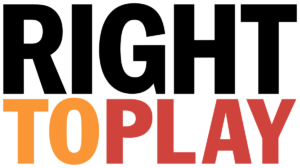 Children learn best through play. That’s the major principle behind Right to Play, a global organization that uses sports and games as tools to help teach kids the essential life skills they need to overcome challenges like poverty, conflict, and disease, and to create better futures for themselves and their communities.
Children learn best through play. That’s the major principle behind Right to Play, a global organization that uses sports and games as tools to help teach kids the essential life skills they need to overcome challenges like poverty, conflict, and disease, and to create better futures for themselves and their communities.
Recently, in its capacity as secretariat to the Sport for Development and Peace International Working Group (SDP IWG, an initiative of the United Nations), Right to Play published a report showcasing a number of different SDP IWG initiatives and looking at the transformative effect these programs had on local children and their communities.
Among these programs was LEARN & play, a program launched in Kabul and Parwan province and spearheaded by the German development organization AfghanistanHilfe Paderborn. Read on to learn more.
What were the objectives of LEARN & play?
With more than half of Afghanistan’s entire population currently under the age of 18, initiatives that target children’s welfare and development are an absolutely vital part of the country’s rebuilding process. Street children are a special focus of many initiatives, as estimates indicate that in Kabul alone, as many as 20,000 children are living on the street with no permanent home or adult care.
The objectives of LEARN & play were to provide disadvantaged children in Kabul with the opportunity to attend school regularly and to participate in sports and games, to provide street children in particular with a safe environment for learning and skills development, and to teach them skills essential to future success like reading and writing and computer skills. The program also sought to teach participants about cooperation and conflict resolution skills through football.
How was the LEARN & play program designed?
The target demographic for LEARN & play was children aged 8 to 12 who were either living on the street, had been orphaned, or were from struggling single-parent homes. In Afghanistan, many children who fit this description have to help provide financial support for themselves and their families, and are therefore able to attend school. Furthermore, life on the streets carries many risks, including the greater likelihood that children will become involved in crime and drugs.
The LEARN & play initiative used football to attract children to the program; the idea being that the program’s participants would come for the football and stay for the academic training. As part of the program, children received one meal; three hours of academic lessons in fundamental subjects like reading, writing, computers, and English; and two hours of football practice.
All classes were taught by instructors approved by Afghanistan’s Ministry of Education and were held in the safe environment of buildings belonging to AfghanistanHilfe Paderborn, the program’s lead organization. Two centers for the program were established—one in Kabul and one in the eastern province of Parwan—and classes were held in shifts so that more children could attend. For maximum effectiveness, eligibility for the LEARN & play program required a five-year commitment from the participants.
What organizations were involved in the delivery of LEARN & play?
While AfghanistanHilfe Paderborn was responsible for overall administration and project coordination, a number of other groups provided additional support for LEARN & play. These included the Afghanistan Football Association, which organized football teams and tournaments; Handicap International, which provided training clinics for team coaches; Afghanistan’s Ministry of Education, which oversaw the teachers employed in LEARN & play’s non-formalized schools; and the Fédération Internationale de Football Association (FIFA), which provided financial support for the curriculum design of the program, as well as much-needed moral support for project staff.
What impact did LEARN & play have?
LEARN & play reached approximately 600 of Afghanistan’s most disadvantaged children: 400 in Kabul and 200 in Parwan province. At the start of the project, only about 10% of participating children were enrolled in a formal school; by the end of the project, that figure had grown to 60%.
Based on reports from project staff members, LEARN & play participants developed greater self-confidence and became more energetic and more cooperative as a result of their football training. Because of the teamwork involved in playing football, children also had plenty of opportunities to practice problem solving and positive conflict resolution, and to boost their communication and interpersonal skills by interacting with a diverse range of people, both peers and adults, with whom they would not likely have had contact before the program.
The children also enjoyed greater recognition from their neighbors and peers as a result of LEARN & play’s respected community status; street children and orphans are often marginalized in Afghan society. Finally, LEARN & play provided important health benefits for participants, both through the provision of a daily meal and through the regular physical activity at football sessions, which helped improve their strength, stamina, and coordination.
